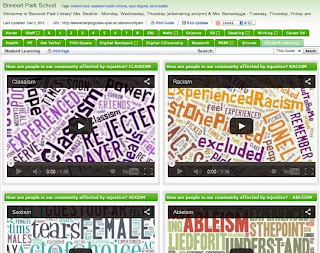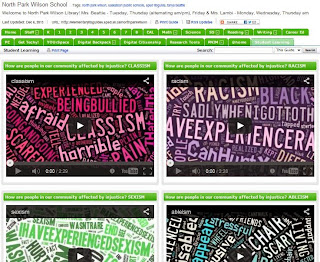Compose & Create
CC8.2: Create and present a group inquiry project related to a topic, theme, or issue studies in English Language Arts.
Indicators:
- Determine personal knowledge of a topic to generate possible areas of inquiry or research.
- Formulate relevant questions on a topic to establish a purpose for gathering information.
- Contribute ideas, knowledge, and strategies to help identify group information needs and sources.
- Collaborate with others using technology to plan inquiry.
- Prepare and use a plan to access, gather, and record in own words relevant information.
- Gather information from a variety of sources (e.g., interviews, print texts, Internet) and integrate ideas in analysis.
- Organize information and ideas in order of priority according to topic and task requirements.
- Make notes in point form, summarizing major ideas and supporting details.
- Sort, organize, classify, and extend data using information technology tools.
- Adjust inquiry and research strategies to accommodate changing perspectives and availability of pertinent information.
- Document cited resources within presentations and composition.
- Use the language of inquiry (e.g., “What processes or procedures could we use?”, “What criteria will we use to judge how effective the sources and processes are in addressing the topic?”, “How can we prepare a presentation suitable for the purpose, audience, and situation that we identified?”)
Comprehend & Respond
CR 8.1: View, listen to, read, comprehend, and respond to a variety of texts that address social responsibility
CR 8.2: Select and use appropriate strategies to construct meaning before (e.g., previewing and anticipating message), during (e.g., making inferences based on text and prior knowledge), and after (e.g., paraphrasing and summarizing) viewing, listening, and reading.
CR 8.4: View critically and demonstrate comprehension of a variety of visual and multimedia texts including videos, television broadcasts, informational presentations, dramatic presentations, websites, and news programs to locate and interpret key messages and details, to develop conclusions, opinions, and understanding, and to evaluate the effectiveness of the text.
CR 8.5: Listen critically to understand, gather information, follow directions, form an opinion, and analyze oral presentations for diverse opinions, presenter’s point of view, values, and biases, stereotypes, or prejudices.
CR 8.7: Read independently and demonstrate comprehension of a variety of information texts including understanding the main ideas and supporting evidence, explaining connections between new ideas and information and previous thoughts, and recognizing any biases or false reasoning.
Overarching Essential Question:
What are our responsibilities to others?
Tertiary questions:
How have people been discriminated against because of their colour, gender, religion, sexual orientation or race?
How have innocent people suffered so others can gain?
What are our responsibilities when injustices occur to others?
How can an individual address injustice (past and present?)
At what age should individuals be held responsible for their decisions?
Collaboration Process – The collaboration process on this project went well. Initial planning was started on GoogleDoc. Both teachers and the teacher librarian had the ability to access and edit the document as plans formed and changed over time.
 All collaborators read Comprehension & Collaboration – Inquiry Circles in Action by Stephanie Harvey & Harvey Daniels. We used this resource as a guide to planning our inquiry unit.
All collaborators read Comprehension & Collaboration – Inquiry Circles in Action by Stephanie Harvey & Harvey Daniels. We used this resource as a guide to planning our inquiry unit.
Chapter 7 – Key Lessons in Comprehension, Collaboration, and Inquiry “outlines the specific lessons we teach in comprehension, collaboration, and inquiry. It follows the instructional approach called the Gradual Release of Responsibility, which scaffolds kids with modeling and guided practice as they move to independence.”
There are “twenty-seven practical lessons that helps kids become thoughtful, independent readers, thinkers, communicators, and researchers” (page 110 Comprehension & Collaboration – Inquiry Circles in Action by Stephanie Harvey & Harvey Daniels), and these lessons provided the framework for our inquiry planning.
We started with the Immerse Stage.
During this stage, considerable time was spent determining readiness to learn, interest in topic, building background, and developing an inquiry stance.
 We followed up with discussion and students then came up with sub-questions to our guiding inquiry question - "What are our responsibilities to others?"
We followed up with discussion and students then came up with sub-questions to our guiding inquiry question - "What are our responsibilities to others?"
"What causes individuals to not take action to help others?"
 Each grade 8 teacher displayed a wonder wall in their classroom. Students wrote their sub-questions and “I wonder” statements on sticky notes and placed them on the wonder wall.
Each grade 8 teacher displayed a wonder wall in their classroom. Students wrote their sub-questions and “I wonder” statements on sticky notes and placed them on the wonder wall.
Resources -
Each classroom displayed a Holocaust classroom library that was filled with resources from the school library. A Holocaust page was developed with resources for students and teachers.

Brevoort Park- http://elementarylibguides.spsd.sk.ca/bpkHOLOCAUST
North Park Wilson - http://elementarylibguides.spsd.sk.ca/TheHolocaust
Through the Immerse stage, grade 8 students built their background knowledge through a series of lessons.
Viewing & Discussion-
Students viewed a video from the United States Holocaust Museum together. The video prompted much discussion.
Classroom teachers and grade 8 students co-constructed Turn and Talk Guidelines. Students worked together to better understand what they had viewed through discussion with one another.
Students determined that a good discussion includes:
-Asking questions
-Listening to others
-Monitoring to stay on topic
-Voicing ideas
-Responding to others ideas
-Constructing understanding together
Annotating text -
Students showed their understanding of various articles by annotating text. Students left tracks of their thinking and teachers were better able to understand what their students were thinking as they read by seeing this annotated text.
The grade 8 students have done this in the past by using a highlighter and sticky notes, but they hadn't annotated text using a digital tool.
Grade 8 students were given the opportunity to annotate text using either Word or Adobe.
Think & Wonder about Images -
Paying attention to images was important throughout the inquiry process because images provided extensive information - visual literacy was key when reading informational text. During the immerse stage, images provided background knowledge about the Holocaust to students.
Students kept track of their questions and thoughts while viewing the images using Lino.
During this stage, considerable time was spent developing questions, searching for information, and discovering answers.
The students were given the opportunity to determine what are our responsibilities to others. They looked deeper into the meaning of injustice. They also investigated to determine how they could contribute to awareness of past injustices, in particular the Holocaust.
A successful authentic performance task has the following characteristics:
It is realistic. It simulates the way a person’s knowledge and abilities are tested in the real world.
It requires judgment and innovation. A student has to use knowledge and skills wisely and effectively to solve a real-world problem.
It replicates or simulates the contexts in which adults are tested in the workplace, the community, or the home.
It assesses the student’s ability to efficiently and effectively use a variety of knowledge and skills to negotiate a complex task.
 Students used text and visual features to gain information. Teachers provided nonfiction texts about the Holocaust at various levels.
Students used text and visual features to gain information. Teachers provided nonfiction texts about the Holocaust at various levels. “At all stages of inquiry projects we want kids to think about and learn from the text and visual features as they research their questions and read for information (p. 119 - Comprehension & Collaboration – Inquiry Circles in Action by Stephanie Harvey & Harvey Daniels).
“At all stages of inquiry projects we want kids to think about and learn from the text and visual features as they research their questions and read for information (p. 119 - Comprehension & Collaboration – Inquiry Circles in Action by Stephanie Harvey & Harvey Daniels). We were then ready for the Coalesce Stage.
Students combined their understandings in order to construct, blend, and build new knowledge.
· Intensify Research· Synthesize Information
· Build Knowledge
In this stage, students planned their contribution to the Holocaust newspaper. Students reflected on everything that they had learned about the historical injustices that occurred during the Holocaust.
During the Coalesce stage, students used information they learned to construct, blend and build new knowledge. 

Students reexamined their inquiry question and began the important work of constructing and building information (Read with a Question in Mind - p. 123 - Comprehension & Collaboration – Inquiry Circles in Action by Stephanie Harvey & Harvey Daniels).
Other lessons included synthesizing information from a variety of sources & citing sources.
Our checklist for teaching and learning strategies / scaffolding for the Coalesce stage included...
-what are the qualities of a good question-how to find reliable sources,
-how to credit sources (text & images)
-how to determine importance & take notes
Both grade 8 classes will be attending the Congregation Agudas Israel Holocaust Memorial Student Event on May 1st or 2nd.
Students will have the opportunity to listen to speaker Robbie Waisman, who was sent to Buchenwald at age 13. They will view large posters chronicling the timeline of the holocaust, as well as other displays. This will be a powerful day!
Our final stage in the Inquiry process will be the Go Public Stage.
Students will showcase their learning to their intended audience in order to enlighten others about their specific topic. Characteristics of this stage will include:
· Share Learning· Demonstrate Understanding and Learning in a Variety of Ways
· Take Action
In the Go Public Stage, our checklist for teaching and learning strategies / scaffolding will include...
-student reflection & articulation of learning process
There is much student choice for ways students will share their learning and demonstrate understanding. Students may share their learning in a variety of ways, including; in writing, orally, visually, or by multimedia methods. Each student will contribute to the online newspaper.
Students may embed a piece of their artwork, use images and text to create a poster which documents their learning (Comic Life), create an interview or podcast (audioboo or voicethread), create a video (animoto), create a timeline (dipity), create a word cloud (tagxedo), etc.
The newspapers will be shared with our school community, with parents, and with a much larger audience. The newspapers will be posted online (BVP LibGuide & NPW LibGuide). Students from each grade 8 class are looking forward to seeing the work of students in the other grade 8 class.
We feel confident that students will be able to answer our original inquiry question; "What are our responsibilities to others?".































